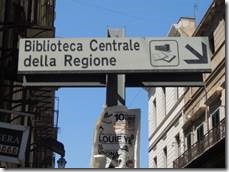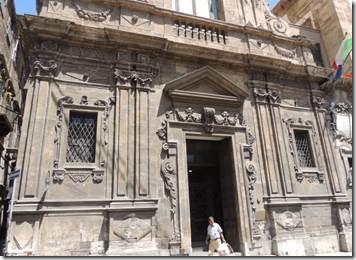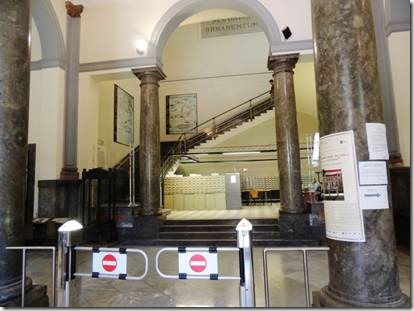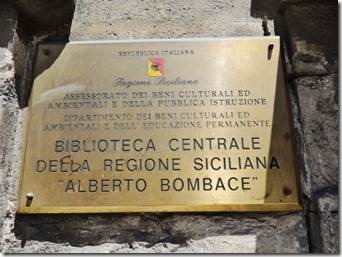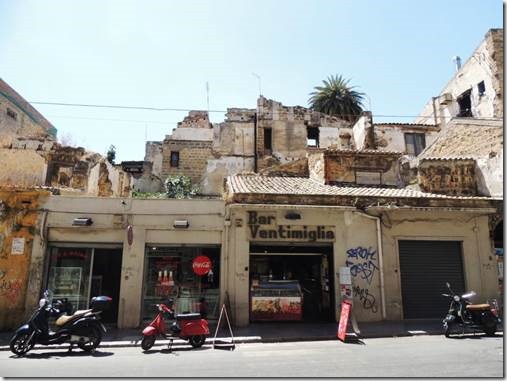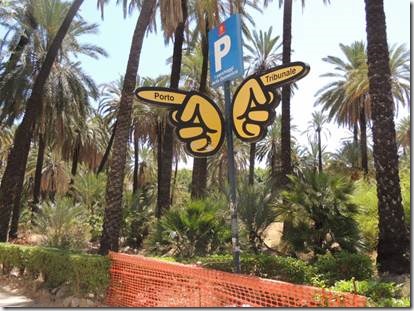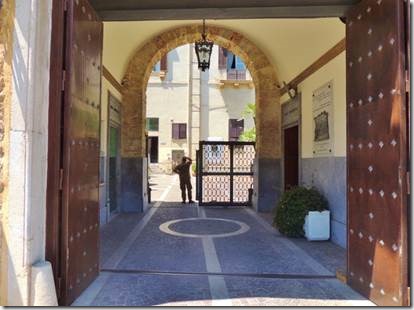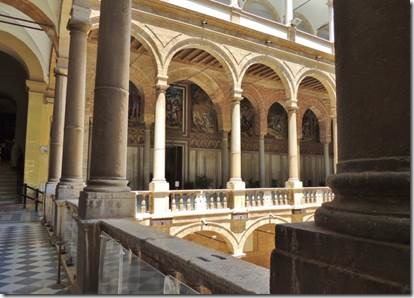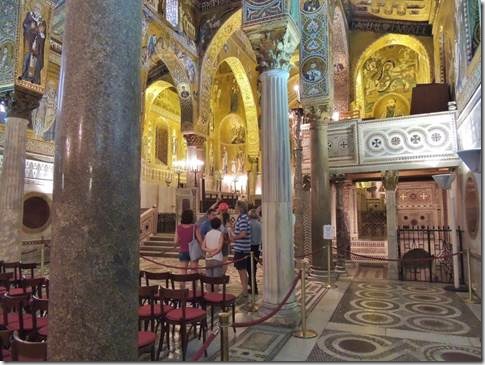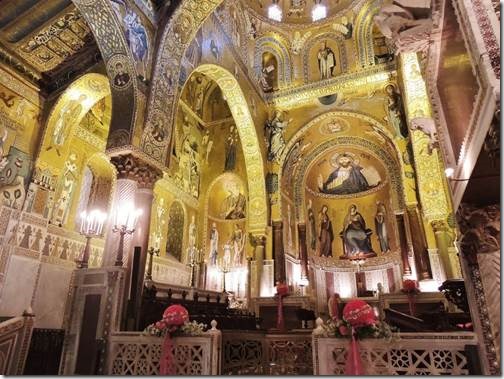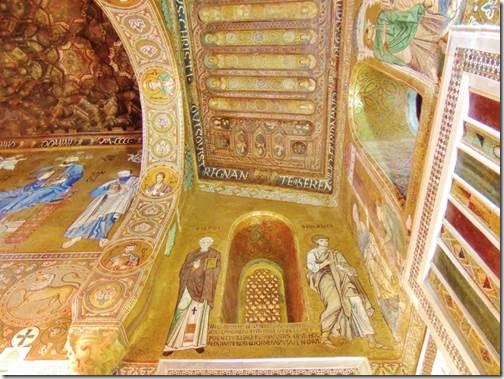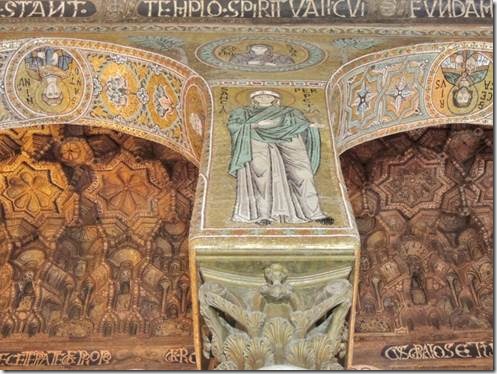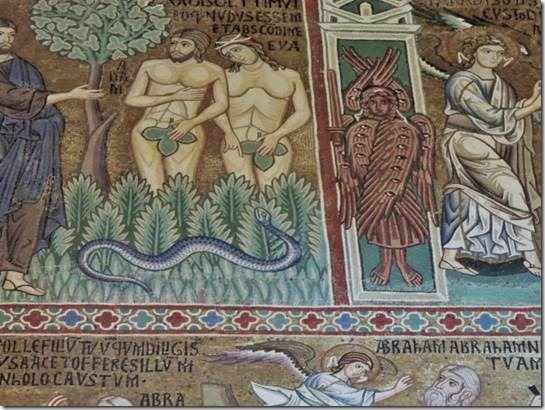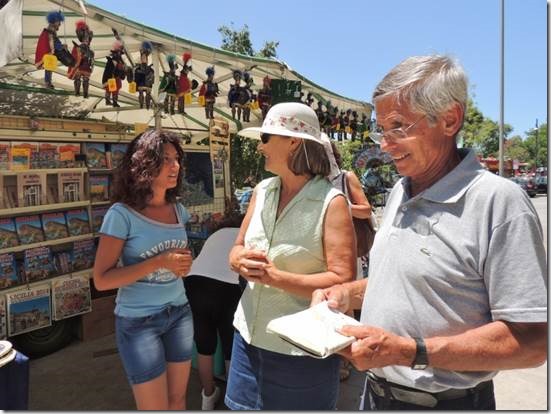Ciao
Our first morning in Palermo we saw the Central Library and the Cappella Palatina. I had the literary traveler tour and Linda and Frank had an actual Sicily tour book with a very useful map, so between us we saw quite a bit.
Ru
Biblioteca Centrale della Regione & Cappella Palatina
|
I couldn’t resist a stop into the Regional Central Library. They men behind the desk to the right of the photo said No Photo inside. They also said something about documents. Either we needed documents to enter or it was a document library. Reading about it, the only English info I could find makes it sound an interesting place. Biblioteca centrale della Regione siciliana"Alberto Bombace" A parchment roll divided into 10 sections written in Hebrew, illustrating in miniature an episode of the Book of Esther, in the Central Library of the Region in Palermo. http://dieli.net/SicilyPage/JewishSicily/JewishTraces.html “The Central Library of the Sicilian Region is the most recent designation of an Institute existing since 1782. The Royal Library was opened by order of Ferdinand l inside the monumental complex consisting of the College of the Jesuits and the baroque church of S. Maria’s Grotto. The Society of Jesus had been expelled 1767. Once Italy was unified it took the name of National Library. The institution has been enriched through the years by numerous purchases and private donations. During World War II the Library was heavily bombed and temporarily moved to a palace in Via Maqueda Mazzarino. The Library was returned to this original seat in 1948 after a restoration. Since 1948 work has continued with the construction of a "book tower" at least 26 meters high, the construction of the reading room, the remaking of the General Reading Room. In 1977, following the transfer of powers in relation to cultural property by the State to the Region of Sicily the Library has assumed the name of Central Library of the Sicilian Region. In 1979, the calamitous collapse of the upper gallery of the library forced to a new closure and long restoration project completed in 1985. The library contains a vast and rich collection of valuable books, such as Arabs codes, Greeks and Latins texts. Among the collections are reported complete certainly that of Didot and Teubner Greek and Latin classics http://www.tripadvisor.com/Travel-g187890-d1437277/Palermo:Sicily:Biblioteca.Regionale.html |
|
War destruction across the road. A passerby told us the real photo was across the street from the library; the unreconstructed war damage. We saw other examples during our strolling. |
|
Port one way; courts the other. I’ve no idea why this combination other than the fickle finger of fate. |
|
The backside of the Pallazzo dei Normanni ; the location of the Cappella Palatina We had no exact idea where in the complex to find the Cappella Palatina but when we asked about entry here, not only were we told No, but the gates were closed on us. A kind local told us we had to go around the other side of the complex. We found our way to the front entrance and to the confusing ticket booth. It was hard to tell what was free, what had a lower fee and what had the higher fee. Turns out, ours was the middle fee as the royal apartments were closed but the Cappella Palatina was open. I’ve no idea what was free. |
|
“Located within the Palazzo dei Normanni (Palace of the Normans), the Cappella Palatina (Palatine Chapel) is the finest example of Arab-Norman art in Palermo. Built by Roger II from 1130 to 1140, the chapel is adorned with extraordinary Norman-Byzantine mosaics. Together the palace and its chapel are the greatest attractions of Palermo and the only must-see sight for visitors with limited time. (Not sure I’d agree, but whatever.) The palace was originally built for the Arab emirs and their harems in the 9th century, on a site earlier occupied by Roman and Punic fortresses. Eventually abandoned by the Arabs, the palace was fully restored by the conquering Normans. The Palatine Chapel was completed by the Norman king Roger II in 1140. After the Normans left, the palace fell into serious decay until it was discovered by Spanish viceroys. In 1555, they began to restore it and it became a royal residence once again. Today, the Palazzo dei Normanni is the seat of Sicily’s semi-autonomous regional government.” http://www.sacred-destinations.com/italy/palermo-cappella-palatina has more photos and descriptions. http://www.wga.hu/html_m/zgothic/mosaics/4palatin/index.html has good photos and description of the mosaic images. |
|
Cappella Palatina entrance There was that nasty No Photo sign just at the entry; but here it meant No Flash. |
|
It actually was pretty impressive with mosaic artwork everywhere. |
|
My momma was from and my poppa was from… Linda, whose mother and father were born in Sicily, made friends everywhere and that was fun for us too. That’s Frank with the guide book which thankfully had a map. |

